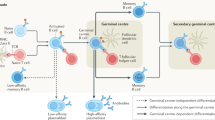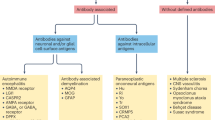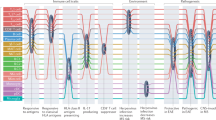Key Points
-
The study of paraneoplastic neurological degenerations (PNDs) provides a means to observe naturally occurring, successful human antitumour immune responses.
-
PND antigens, which are identified using antisera from patients with PNDs to screen expression complementary DNA libraries, can be used to study the specific nature of the associated antitumour immune response.
-
The PND tumour immune response is characterized by the presence of PND antigen-specific CD8+ killer T cells in the blood of patients.
-
An important trigger of PND antigen-specific CD8+ killer T cells in patients with cancer is likely to be the capture of apoptotic tumour cells by tissue dendritic cells, which then migrate to the lymph node to activate T cells.
-
The activation of CD8+ killer T cells in the lymph node appears to depend on the presence of CD4+ helper T cells; in their absence, CD8+ T cells might become tolerized.
Abstract
Paraneoplastic neurological degenerations (PNDs) are neurological disorders that develop in patients with cancer. PNDs are triggered by an effective antitumour immune response against neuronal antigens that are expressed in cancer cells, which subsequently develops into autoimmune neurodegenerative disease. Studying patients with PND has offered the opportunity to gain unique insights into mechanisms of tumour immunity and has provided the potential to apply this knowledge to patients with cancer in general.
This is a preview of subscription content, access via your institution
Access options
Subscribe to this journal
Receive 12 print issues and online access
$209.00 per year
only $17.42 per issue
Buy this article
- Purchase on Springer Link
- Instant access to full article PDF
Prices may be subject to local taxes which are calculated during checkout


Similar content being viewed by others
References
Burnet, F. M. Cancer: a biological approach. Brit. Med. J. 1, 841–847 (1957).
Thomas, L. Cellular and humoral aspects of the hypersensitivity states. in Discussion to P. B. Medawar's paper. (ed. Lawrence, H. S.) 529–534 (Harper, New York, 1959).
Dunn, G. P., Bruce, A. T., Ikeda, H., Old, L. J. & Schreiber, R. D. Cancer immunoediting: from immunosurveillance to tumor escape. Nature Immunol. 3, 991–998 (2002). An up-to-date review of tumour immunology, including historical aspects, animal models and a partial discussion of human tumour immunity issues.
Dickey, C. Review reopens old disagreements. Nature Med. 8, 1337 (2002).
Darnell, R. B. & Posner, J. B. Observing the invisible: successful tumor immunity in humans. Nat Immunol. 4, 201 (2003).
Darnell, R. B. & Posner, J. B. Paraneoplastic syndromes of the nervous system. N. Engl. J. Med. 349, 1543–1554 (2003).
Voltz, R. D., Posner, J. B., Dalmau, J. & Graus, F. Paraneoplastic encephalomyelitis: an update of the effects of the anti-Hu immune response on the nervous system and tumour. J. Neurol. Neurosurg. Psychiatr. 63, 133–136 (1997).
Anderson, N. E., Cunningham, J. M. & Posner, J. B. Autoimmune pathogenesis of paraneoplastic neurological syndromes. Crit. Rev. Neurobiol. 3, 245–299 (1987).
Darnell, R. B. & Posner, J. B. Paraneoplastic syndromes involving the nervous system. N. Engl. J. Med. 349, 1543–1554 (2003).
Rojas, I. et al. Long-term clinical outcome of paraneoplastic cerebellar degeneration and anti-Yo antibodies. Neurology 55, 713–715 (2000).
Dalmau, J., Graus, F., Rosenblum, M. K. & Posner, J. B. Anti-Hu associated paraneoplastic encephalomyelitis/ sensory neuropathy: a clinical study of 71 patients. Medicine 71, 59–72 (1991). Classic overview of 71 patients with the Hu PND syndrome.
Posner, J. B. & Furneaux, H. M. Paraneoplastic syndromes. in Immunologic mechanisms in neurologic and psychiatric disease (ed. Waksman, B. H.) 187–219 (Raven Press Ltd., New York, 1990).
Dalmau, J., Furneaux, H. M., Rosenblum, M. K., Graus, F. & Posner, J. B. Detection of the anti-Hu antibody in specific regions of the nervous system and tumor from patients with paraneoplastic encephalomyelitis/sensory neuronopathy. Neurology 41, 1757–1764 (1991).
Anderson, N. E., Rosenblum, M. K. & Posner, J. B. Paraneoplastic cerebellar degeneration: clinical-immunological correlations. Ann. Neurol. 24, 559–567 (1988).
Hetzel, D., Stanhope, C., O'Neill, B. & Lennon, V. Gynecologic cancer in patients with subacute cerebellar degeneration predicted by anti-Purkinje cell antibodies and limited in metastatic volume. Mayo Clin. Proc. 65, 1558–1563 (1990).
Graus, F. et al. Anti-Hu-associated paraneoplastic encephalomyelitis: analysis of 200 patients. Brain 124, 1138–1148 (2001).
Peterson, K., Rosenblum, M. K., Kotanides, H. & Posner, J. B. Paraneoplastic cerebellar degeneration. I. A clinical analysis of 55 anti-Yo antibody-positive patients. Neurology 42, 1931–1937 (1992). Analysis of 55 patients with the PCD syndrome.
DeVita, V. T., Hellman, S. & Rosenberg, S. Cancer, Principles and Practice of Oncology. (J. B. Lippincott Company, Philadelphia, 1993).
Maddison, P., Newsom-Davis, J., Mills, K. R. & Souhami, R. L. Favourable prognosis in Lambert-Eaton myasthenic syndrome and small-cell lung carcinoma. Lancet 353, 117–118 (1999).
Graus, F. et al. Anti-Hu antibodies in patients with small-cell lung cancer: association with complete response to therapy and improved survival. J. Clin. Oncol. 15, 2866–2872 (1997).
Darnell, R. B. The importance of defining the paraneoplastic neurologic disorders. N. Engl. J. Med. 340, 1831–1833 (1999).
Rosenblum, M. K. Paraneoplasia and autoimmunologic injury of the nervous system: the anti-Hu syndrome. Brain Pathol. 3, 199–212 (1993).
Mason, W. P., Dalmau, J., Curtin, J. P. & Posner, J. B. Normalization of the tumor marker CA-125 after oophorectomy in a patient with paraneoplastic cerebellar degeneration without detectable cancer. Gynecol. Oncol. 65, 173–176 (1997).
Darnell, R. B. & DeAngelis, L. M. Regression of small-cell lung carcinoma in patients with paraneoplastic neuronal antibodies. Lancet 341, 21–22 (1993). First clear description of patients with PND that had well-documented spontaneous regression of tumours upon PND onset.
Zaheer, W. et al. Spontaneous regression of small cell carcinoma of lung associated with severe neuropathy. Cancer Invest. 11, 306–309 (1993).
Byrne, T., Mason, W. P., Posner, J. B. & Dalmau, J. Spontaneous neurological improvement in anti-Hu associated encephalomyelitis. J. Neurol. Neurosurg. Psychiatr. 62, 276–278 (1997).
Verschuuren, J. et al. Inflammatory infiltrates and complete absence of Purkinje cells in anti-Yo-associated paraneoplastic cerebellar degeneration. Acta Neuropathol. 91, 519–525 (1996).
Wilkinson, P. C. & Zeromski, J. Immunofluorescent detection of antibodies against neurones in sensory carcinomatous neuropathy. Brain 88, 529–583 (1965).
Trotter, J., Hendin, B. & Osterland, C. Cerebellar degeneration with Hodgkin's disease: an immunological study. Arch. Neurol. 33, 660–661 (1976).
Croft, P. B., Henson, R. A., Urich, H. & Wilkinson, P. C. Sensory neuropathy with bronchial carcinoma a study of four cases showing serological abnormalities. Brain 88, 501–514 (1965).
Henson, R. A. & Urich, H. Cancer and the nervous system: The neurologic manifestaions of systemic malignant disease. (Blackwell Scientific, London, 1982).
Jaeckle, K. et al. Autoimmune response of patients with paraneoplastic cerebellar degeneration to a Purkinje cell cytoplasmic protein antigen. Ann. Neurol. 18, 592–600 (1985).
Cunningham, J., Graus, F., Anderson, N. & Posner, J. B. Partial characterization of the Purkinje cell antigens in paraneoplastic cerebellar degeneration. Neurology 36, 1163–1168 (1986).
Graus, F., Cordon-Cardo, C. & Posner, J. Neuronal antinuclear antibody in sensory neuronopathy from lung cancer. Neurology 35, 538–543 (1985).
Graus, F., Elkon, K. B., Cordon-Cardo, C. & Posner, J. B. Sensory neuronopathy and small cell lung cancer; antineuronal antibody that also reacts with the tumor. Am. J. Med. 80, 45–52 (1986).
Furneaux, H. F., Reich, L. & Posner, J. B. Autoantibody synthesis in the central nervous system of patients with paraneoplastic syndromes. Neurology 40, 1085–1091 (1990).
Darnell, R. B. Onconeural antigens and the paraneoplastic neurologic disorders: at the intersection of cancer, immunity and the brain. Proc. Natl Acad. Sci. USA 93, 4529–4536 (1996).
Musunuru, K. & Darnell, R. B. Paraneoplastic neurologic disease antigens: RNA-binding proteins and signaling proteins in neuronal degeneration. Annu. Rev. Neurosci. 24, 239–262 (2001).
Folli, F. et al. Autoantibodies to a 128-kd synaptic protein in three women with the stiff-man syndrome and breast cancer. N. Engl. J. Med. 328, 546–551 (1993).
Okano, H. J., Park, W. Y., Corradi, J. P. & Darnell, R. B. The cytoplasmic Purkinje antigen cdr2 downregulates Myc function: implications for neuronal and tumor cell survival. Genes Dev. 13, 2087–2098 (1999).
Corradi, J. P., Yang, C. W., Darnell, J. C., Dalmau, J. & Darnell, R. B. A post-transcriptional regulatory mechanism restricts expression of the paraneoplastic cerebellar degeneration antigen cdr2 to immune privileged tissues. J. Neurosci. 17, 1406–1415 (1997).
Dredge, B. K. & Darnell, R. B. Nova regulates GABA(A) receptor γ2 alternative splicing via a distal downstream UCAU-rich intronic splicing enhancer. Mol. Cell. Biol. 23, 4687–4700 (2003).
Dredge, B. K., Polydorides, A. D. & Darnell, R. B. The splice of life: alternative splicing and neurological disease. Nature Rev. Neurosci. 2, 43–50 (2001).
Jensen, K. B. et al. Nova-1 regulates neuron-specific alternative splicing and is essential for neuronal viability. Neuron 25, 359–371 (2000).
Brennan, C. M. & Steitz, J. A. HuR and mRNA stability. Cell. Mol. Life Sci. 58, 266–277 (2001).
Keene, J. D. Why is Hu where? Shuttling of early-response-gene messenger RNA subsets. Proc. Natl Acad. Sci. USA 96, 5–7 (1999).
Furneaux, H. M. et al. Selective expression of Purkinje-cell antigens in tumor tissue from patients with paraneoplastic cerebellar degeneration. N. Engl. J. Med. 322, 1844–1851 (1990).
Manley, G. T., Smitt, P. S., Dalmau, J. & Posner, J. B. Hu antigens: reactivity with Hu antibodies, tumor expression, and major immunogenic sites. Ann. Neurol. 38, 102–110 (1995).
Dalmau, J., Furneaux, H. M., Cordon-Cardo, C. & Posner, J. B. The expression of the Hu (paraneoplastic encephalomyelitis/ sensory neuronopathy) antigen in human normal and tumor tissues. Am. J. Pathol. 141, 881–886 (1992).
Darnell, J. C., Albert, M. L. & Darnell, R. B. cdr2, a target antigen of naturally occuring human tumor immunity, is widely expressed in gynecological tumors. Cancer Res. 60, 2136–2139 (2000).
Dalmau, J., Furneaux, H. M., Gralla, R. J., Kris, M. G. & Posner, J. B. Detection of the anti-Hu antibody in the serum of patients with small cell lung cancer: a quantitative western blot analysis. Ann. Neurol. 27, 544–552 (1990). Original description of improved prognosis in patients with Hu+ small-cell lung cancer, low-titres of anti-Hu antibodies and no neurological disease.
Corriveau, R. A., Huh, G. S. & Shatz, C. J. Regulation of class I MHC gene expression in the developing and mature CNS by neural activity. Neuron 21, 505–520 (1998).
Darnell, R. B. Immunologic complexity in neurons. Neuron 21, 947–950 (1998).
Albert, M. L. et al. Tumor-specific killer cells in paraneoplastic cerebellar degeneration. Nature Med. 4, 1321–1324 (1998). First identification of PND antigen-specific CTLs in patients with PND antitumour immune responses and demonstration of potency of apoptotic tumour cells as a source of PND antigen for CTL activation.
Albert, M. L., Austin, L. M. & Darnell, R. B. Detection and treatment of activated T cells in the cerebrospinal fluid of patients with paraneoplastic cerebellar degeneration. Ann. Neurol. 47, 9–17 (2000).
Voltz, R., Dalmau, J., Posner, J. B. & Rosenfeld, M. R. T-cell receptor analysis in anti-Hu associated paraneoplastic encephalomyelitis. Neurology 51, 1146–1150 (1998).
Okano, H. J. & Darnell, R. B. A hierarchy of Hu RNA binding proteins in developing and adult neurons. J. Neurosci. 17, 3024–3037 (1997).
Buckanovich, R. J., Posner, J. B. & Darnell, R. B. Nova, the paraneoplastic Ri antigen, is homologous to an RNA-binding protein and is specifically expressed in the developing motor system. Neuron 11, 657–672 (1993).
Buckanovich, R. J., Yang, Y. Y. & Darnell, R. B. The onconeural antigen Nova-1 is a neuron-specific RNA-binding protein, the activity of which is inhibited by paraneoplastic antibodies. J. Neurosci. 16, 1114–1122 (1996).
Bevan, M. J. Cross-priming for a secondary cytotoxic response to minor H antigens with H-2 congenic cells which do not cross-react in the cytotoxic assay. J. Exp. Med. 143, 1283–1288 (1976).
Casciola-Rosen, L. A., Anhalt, G. & Rosen, A. Autoantigens targeted in systemic lupus erythematosus are clustered in two populations of surface structures on apoptotic keratinocytes. J. Exp. Med. 179, 1317–1330 (1994).
Albert, M. L., Sauter, B. & Bhardwaj, N. Dendritic cells acquire antigen from apoptotic cells and induce class I-restricted CTLs. Nature 392, 86–89 (1998). First identification of apoptotic virally infected cells as a source of antigen for CTL activation.
Albert, M. L. & Bhardwaj, N. Resurrecting the dead: dendritic cells acquire antigen from apoptotic cells. The Immunologist 6, 194–198 (1998).
Albert, M. L. et al. Immature dendritic cells phagocytose apoptotic cells via αvβ5 and CD36, and cross-present antigens to cytotoxic T lymphocytes. J. Exp. Med. 188, 1359–1368 (1998). Identification of apoptotic pathway as a means of 'default' tolerization of CD8+ T cells in the absence of CD4 help.
Heath, W. R. & Carbone, F. R. Cross-presentation in viral immunity and self–tolerance. Nature Rev. Immunol. 1, 126–134 (2001).
Forster, R. et al. CCR7 coordinates the primary immune response by establishing functional microenvironments in secondary lymphoid organs. Cell 99, 23–33 (1999).
Cyster, J. G. Leukocyte migration: scent of the T zone. Curr. Biol. 10, R30–R33 (2000).
Banchereau, J. & Steinman, R. M. Dendritic cells and the control of immunity. Nature 392, 245–252 (1998).
Heath, W. R. & Carbone, F. R. Cross-presentation, dendritic cells, tolerance and immunity. Annu. Rev. Immunol. 19, 47–64 (2001).
Guermonprez, P., Valladeau, J., Zitvogel, L., Thery, C. & Amigorena, S. Antigen presentation and T cell stimulation by dendritic cells. Annu. Rev. Immunol. 20, 621–667 (2002).
Albert, M. L., Jegathesan, M. & Darnell, R. B. Dendritic cell maturation is required for the cross-tolerization of CD8+ T cells. Nature Immunol. 9, 1–8 (2001).
Bennett, S. R., Carbone, F. R., Karamalis, F., Miller, J. F. & Heath, W. R. Induction of a CD8+ cytotoxic T lymphocyte response by cross-priming requires cognate CD4+ T cell help. J. Exp. Med. 186, 65–70 (1997).
Schoenberger, S. P., Toes, R. E., van der Voort, E. I., Offringa, R. & Melief, C. J. T-cell help for cytotoxic T lymphocytes is mediated by CD40–CD40L interactions. Nature 393, 480–483 (1998).
Ridge, J. P., Di Rosa, F. & Matzinger, P. A conditioned dendritic cell can be a temporal bridge between a CD4+ T- helper and a T-killer cell. Nature 393, 474–478 (1998).
Carpentier, A. F. et al. DNA vaccination with HuD inhibits growth of a neuroblastoma in mice. Clin. Cancer Res. 4, 2819–2824 (1998).
Orange, D. E. et al. Effective antigen cross-presentation by prostate cancer patients' dendritic cells: implications for prostate cancer immunotherapy. Prostate Cancer Prostatic Dis (in the press).
Albert, M. L., Kim, J. I. & Birge, R. B. αvβ5 integrin recruits the CrkII-Dock180-rac1 complex for phagocytosis of apoptotic cells. Nature Cell Biol. 2, 899–905 (2000).
Kurts, C., Kosaka, H., Carbone, F. R., Miller, J. F. & Heath, W. R. Class I-restricted cross-presentation of exogenous self-antigens leads to deletion of autoreactive CD8+ T cells. J. Exp. Med. 186, 239–245 (1997).
Kurts, C. et al. Constitutive class I-restricted exogenous presentation of self antigens in vivo. J. Exp. Med. 184, 923–930 (1996).
Acknowledgements
This research was supported by the Howard Hughes Medical Institute, the Burroughs Wellcome Fund and the National Institutes of Health. R.B.D. is an Investigator of the Howard Hughes Medical Institute.
Author information
Authors and Affiliations
Corresponding author
Ethics declarations
Competing interests
The authors declare no competing financial interests.
Related links
Related links
DATABASES
Cancer.gov
LocusLink
FURTHER INFORMATION
Glossary
- MAJOR HISTOCOMPATIBILITY COMPLEX
-
(MHC). Highly polymorphic genes that encode cell-surface proteins that bind peptides non-covalently. MHC class I molecules present peptide to CD8+ class T cells and MHC class II molecules present peptides to CD4+ class T cells.
- CELLULAR IMMUNITY
-
Immunity that is mediated by T cells, as opposed to humoral immunity, which is mediated by antibodies.
- OOPHORECTOMY
-
Sugical removal of an ovary or ovaries.
- PAN-SENSORY NEUROPATHY
-
A disease that involves all fibres in the peripheral nerves, including small fibres (pain and temperature) and large fibres (vibration and joint position sense).
- SALPINGO-OOPHORECTOMY
-
Removal of the fallopian tubes and ovaries.
- PURKINJE NEURONS
-
Large inhibitory neurons of the cerebellar cortex.
- KOCH'S POSTULATES
-
Conditions for establishing pathogenicity of a disease-causing agent — for example, it must be present in all cases of the disease; passive transfer of the agent must cause disease in animals; the agent must then be able to be recovered and purified from these animals.
- T-CELL TOLERANCE
-
Involves T cells that do not become activated following exposure to an antigen.
- CYTOTOXIC T LYMPHOCYTES
-
CD8+ T cells that recognize and kill target cells through a binding between the T-cell receptor and a target-cell-surface complex of a peptide antigen attached to a major histocompatibility complex class I molecule.
- ANTIGEN-PRESENTING CELL
-
(APC). A cell that displays peptide–major-histocompatibility-complex complexes in a form that is recognized by T cells.
- MINOR HISTOCOMPATIBILITY ANTIGENS
-
Peptides of polymorphic cellular proteins bound to major-histocompatibility-complex molecules that can lead to graft rejection when they are recognized by T cells.
- EXOGENOUS ANTIGEN
-
A peptide that is expressed outside of, but processed within, an antigen-presenting cell (dendritic cell) for immune stimulation. Classically, extracellular proteins bind to major histocompatibility complex (MHC) class II molecules and are presented to CD4+ T cells. Exogenous antigens that are derived from apoptotic cells are presented on both MHC class I and II molecules, and are presented to CD4+ and CD8+ T cells.
- CD4 HELPER CELL
-
CD4+ T cells that provide stimuli for B cells and, through interactions with dendritic cells, for cytotoxic T cells. They recognize antigen in the context of major histocompatibility complex class II molecules on the surface of antigen-presenting cells.
Rights and permissions
About this article
Cite this article
Albert, M., Darnell, R. Paraneoplastic neurological degenerations: keys to tumour immunity. Nat Rev Cancer 4, 36–44 (2004). https://doi.org/10.1038/nrc1255
Issue Date:
DOI: https://doi.org/10.1038/nrc1255



